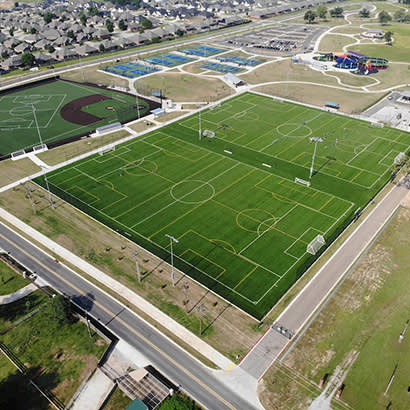
For an enhanced digital experience, read this story in the ezine.
Whether it’s the adage about doing more with less or the one about fitting the round peg into the square hole, it applies to parks.
In the course of trying to expand the offerings for hosting sports (including camps, leagues, school plays, showcases and even travel tournaments) in a limited amount of space, land-locked communities have seen the rise of some incredibly creative field designs. And having these in play can make a tremendous difference in the ability to effectively monetize a facility.
Marking rectangular fields for multiple sports is not a new trend, and it is common to see one field with lines for football, soccer and even lacrosse. But when diamond sports enter that mix, it’s a different story.
“We’re starting to see more requests for adding or including lacrosse lines on not only football and soccer fields, but also in the outfield areas of baseball and softball fields,” says Todd Smith of R&R Surveyors and Engineers, Inc.
Sometimes, adding such fields depends upon installing movable fencing, particularly in cases where baseball or softball outfields will include part of the land currently being taken up by a rectangular field. Fencing used for diamond sports should have padded tops in order to protect players who want to attempt challenging catches in the outfield.
In many cases for recreational and municipal facilities, indoor gymnasiums and outdoor hard-surface sport areas (including tennis or pickleball courts) have added removable nets and posts and put down playing lines for inline roller hockey or even futsal to increase the use of such spaces.
In the case of outdoor sports, how fields are delineated largely depends upon whether a field is natural grass or synthetic turf. In many cases, synthetic fields offer more resistance to wear, allowing multiple games to be run across the surface without fear of having to wait for grass to rebound.
In cases where synthetic turf is used, field builders are making it easier for municipal crews to move fencing to proper locations.
“We installed reference ‘tick’ marks in the field to allow the city crews to ‘connect the dots’ to make paint striping easier and not have the need to measure each time they stripe for a sport,” notes Paul Arcella of CSR Construction Heavy & Athletic.
Because not all paints are suitable for synthetic fields, it is essential to consult the turf manufacturer, which can provide recommendations.
Natural grass fields are less problematic to mark, and with the advent of robotic line-marking systems (something on the uptick), line painting has become far less time consuming. However, it is essential to note that the more fields a sport hosts, the greater the stress will be on the grass.
“Not everyone has the luxury of keeping fields closed to play to allow for the field to recover,” adds Arcella.
A local agronomist can provide information on the best type of grass to use, given the geography, weather, soil conditions and expected use. Even so, it is reasonable to expect to have to rotate play to other areas, should the field start to show signs of stress.
A synthetic field is not a get-out-of-maintenance-free card, however. “It should also be pointed out the synthetic turf fields are low maintenance, not no maintenance,” adds Arcella. “Keeping the playing surface in good shape and playable is, however, much easier than a natural grass field would be. Before any selection of surface is made, the ability to maintain either surface needs to be taken into consideration.”
No matter what the surface of the field, however, one thing is for certain: the demand is increasing. With showcase sports recently added to the Olympics, like cricket, flag football and lacrosse, and with the absolute uptick of girls’ and women’s flag football, as well as rugby, it’s time to rethink the use, and the hosting capabilities, of sports fields at all levels.
One resource that could be useful for those working to maximize the use of their fields is the publication, Sports Fields: Construction and Maintenance Manual, published by the American Sports Builders Association. By thinking outside of the box, we can optimize our park and recreation spaces to better meet the needs and desires of our community members.
Mary Helen Sprecher is Technical Writer at American Sports Builders Association.


